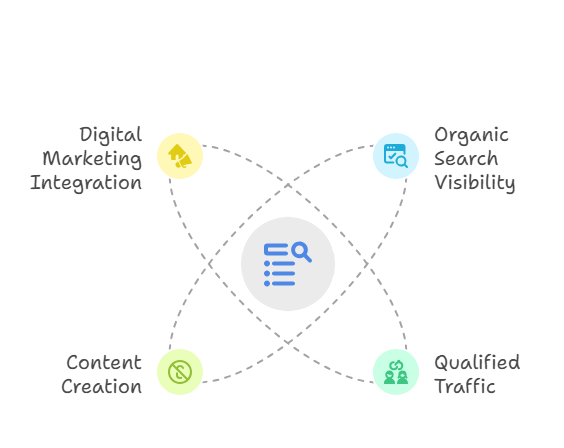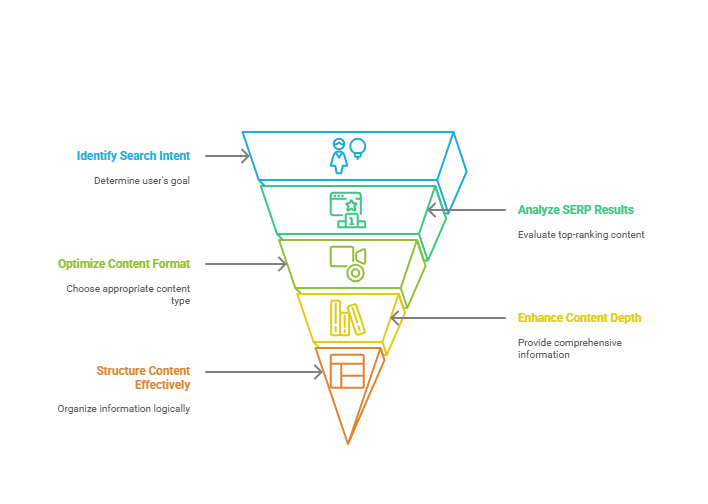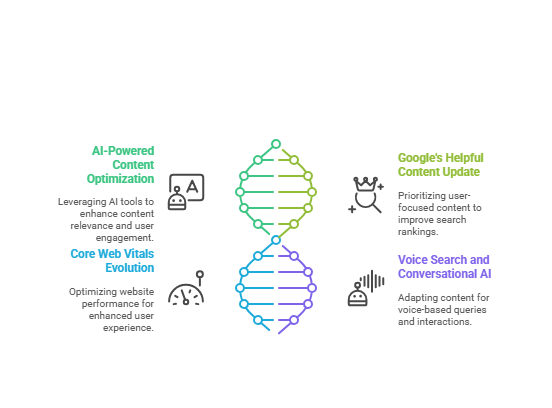Looking to dominate Google search rankings without burning through your marketing budget? You’ve found the definitive resource.
This comprehensive guide reveals the exact SEO strategies that drive consistent, long-term organic traffic growth—complete with real-world case studies, proven tools, and actionable tactics you can implement immediately.
Unlike generic SEO advice that barely scratches the surface, this guide delivers battle-tested strategies used by top-ranking websites.
Whether you’re a business owner, marketing professional, or content creator, these methods will help you climb search rankings and attract high-quality visitors who convert into customers.
What Is an SEO Strategy?
An SEO strategy is your comprehensive roadmap for increasing organic search visibility and driving qualified traffic to your website. According to Backlinko’s latest research, websites with documented SEO strategies are 3.2 times more likely to see significant traffic growth within 12 months compared to those using ad-hoc tactics.

Think of your SEO strategy as the blueprint that connects every piece of your digital marketing efforts. It’s not just about ranking higher—it’s about attracting the right audience at the perfect moment in their buying journey.
“The most successful SEO strategies focus on creating remarkable content that serves users first, not search engines. When you solve real problems for real people, rankings follow naturally.” – Brian Dean, Backlinko
Why Strategic SEO Outperforms Random Tactics
Random SEO efforts produce random results. Strategic SEO creates predictable, scalable growth. Here’s what happens when you implement a cohesive strategy:
- Compound effect: Each optimized page strengthens your overall domain authority
- Targeted traffic: You attract visitors actively searching for your solutions
- Competitive advantage: You systematically outrank competitors across multiple keywords
- Long-term ROI: Organic traffic continues flowing without ongoing ad spend
Research from Ahrefs shows that 91% of web pages receive zero organic traffic from Google—primarily because they lack strategic optimization. Don’t let your content join that statistic.
Step 1: Master Strategic Keyword Research
Effective keyword research forms the foundation of every successful SEO campaign. It’s not about finding the most popular terms—it’s about discovering the exact phrases your ideal customers use when they’re ready to engage with your business.
The Modern Keyword Research Framework
Follow this proven process to uncover high-value keyword opportunities:
- Seed keyword identification: Start with 5-10 broad terms that describe your business
- Competitor analysis: Use Ahrefs or SEMrush to analyze competitors’ top-performing keywords
- Long-tail discovery: Focus on 3+ word phrases with specific intent
- Search volume validation: Target keywords with 500+ monthly searches but manageable competition
- Intent classification: Categorize keywords by informational, commercial, or transactional intent
The Golden Ratio: Low Competition, High Commercial Intent
The most profitable keywords combine manageable competition with strong commercial intent. According to Neil Patel’s latest research, targeting keywords with difficulty scores under 40 can increase ranking success rates by 67%.
“Focus on keywords where you can realistically rank within 6 months. It’s better to dominate 10 achievable keywords than struggle for years with impossibly competitive terms.” – Neil Patel
Step 2: Create Content That Matches Search Intent
Google’s algorithm has evolved far beyond simple keyword matching. Today’s search engine prioritizes content that perfectly satisfies user intent. According to Google’s official documentation, understanding search intent is critical for ranking success.

The Four Pillars of Search Intent
- Informational Intent: Users seeking knowledge (“how to improve website speed”)
- Navigational Intent: Users searching for specific websites (“Google Search Console login”)
- Commercial Investigation: Users researching purchases (“best email marketing software 2025”)
- Transactional Intent: Users ready to buy (“buy domain name online”)
The SERP Analysis Method
Before creating content, analyze the top 10 Google results for your target keyword. This reveals exactly what format and depth Google considers most relevant:
- Content format: Are results primarily blog posts, product pages, or videos?
- Content depth: How comprehensive are the top-ranking articles?
- Content angle: What unique perspective or benefit do they emphasize?
- Content structure: How do they organize information (lists, guides, comparisons)?
“The SERP is Google’s syllabus. It shows you exactly what content format, depth, and angle you need to compete effectively.” – Rand Fishkin, SparkToro
Content Optimization Checklist for Maximum Engagement
- Hook readers immediately: Your first 50 words determine whether visitors stay or leave
- Use the inverted pyramid: Lead with key information, then provide supporting details
- Include actionable takeaways: Every section should provide specific, implementable advice
- Add visual elements: Break up text with images, charts, and infographics
- Optimize for featured snippets: Structure content to answer questions concisely
Step 3: Optimize Your Pages (On-Page SEO)
On-page SEO ensures search engines understand your content’s topic, relevance, and value. Research from Moz indicates that properly optimized pages rank an average of 42% higher than those with basic optimization.
The Complete On-Page Optimization Framework
Title Tag Optimization:
- Include primary keyword within the first 60 characters
- Write compelling, click-worthy titles that stand out in search results
- Use power words like “complete,” “ultimate,” or “proven” to increase CTR
Header Structure Optimization:
- Use one H1 tag containing your primary keyword
- Create descriptive H2 and H3 tags that include related keywords
- Maintain logical hierarchy for better user experience and crawlability
Meta Description Excellence:
- Write compelling 150-160 character summaries
- Include primary keyword naturally within the description
- Add clear value propositions or benefits to encourage clicks
Internal Linking Strategy for Authority Distribution
Strategic internal linking passes authority between pages and helps search engines understand your site’s topical relationships. Implement these best practices:
- Use descriptive anchor text: Avoid generic phrases like “click here”
- Link to relevant content: Connect related topics to keep users engaged
- Create content hubs: Build pillar pages that link to comprehensive subtopic clusters
- Distribute link equity: Ensure important pages receive multiple internal links
Mobile-First Optimization Essentials
With 63% of Google searches now happening on mobile devices, mobile optimization directly impacts rankings:
- Ensure all elements display correctly on mobile screens
- Use readable font sizes (minimum 16px) without zooming
- Make buttons and links easily tappable (minimum 44px)
- Test page speed on mobile using Google PageSpeed Insights
Step 4: Fix Technical SEO Issues
Technical SEO forms the foundation that supports all other optimization efforts. Even exceptional content can’t overcome fundamental technical problems. Search Engine Land research shows that 58% of websites have critical technical issues preventing optimal search performance.
Core Web Vitals: Google’s User Experience Signals
Google’s Core Web Vitals directly impact rankings. Focus on these three critical metrics:
- Largest Contentful Paint (LCP): Main content should load within 2.5 seconds
- First Input Delay (FID): Page should respond to interactions within 100 milliseconds
- Cumulative Layout Shift (CLS): Visual stability score should remain below 0.1
Technical SEO Audit Checklist
Crawlability and Indexation:
- Submit XML sitemap to Google Search Console
- Fix broken internal and external links
- Implement proper robots.txt file
- Resolve duplicate content issues with canonical tags
Site Architecture Optimization:
- Create logical URL structure with descriptive slugs
- Implement breadcrumb navigation
- Ensure important pages are within 3 clicks of homepage
- Use HTTPS encryption for security and ranking benefits
“Technical SEO isn’t glamorous, but it’s the foundation everything else builds on. Fix the technical issues first, then watch your content optimization efforts deliver better results.” – Marie Haynes, SEO Consultant
Essential Technical SEO Tools
- Google Search Console: Monitor crawl errors, Core Web Vitals, and indexing status
- Screaming Frog SEO Spider: Comprehensive site crawling and technical analysis
- GTmetrix: Detailed page speed analysis and optimization recommendations
- Google PageSpeed Insights: Core Web Vitals assessment and improvement suggestions
Step 5: Build High-Quality Backlinks
Backlinks remain one of Google’s strongest ranking signals. However, quality far outweighs quantity. According to Ahrefs’ analysis of 1 billion pages, a single high-authority backlink can be worth more than 100 low-quality links.
High-Value Link Building Strategies
Digital PR and Newsworthy Content:
- Create original research studies with compelling statistics
- Develop interactive tools or calculators for your industry
- Publish trend reports or industry surveys
- Offer expert commentary on breaking news in your field
Strategic Guest Content:
- Target high-authority sites in your industry
- Pitch unique, valuable content ideas
- Focus on building relationships, not just acquiring links
- Provide actionable insights your target audience needs
Broken Link Building:
- Use Ahrefs to find broken links on relevant websites
- Create superior replacement content
- Reach out with helpful, non-pushy suggestions
- Follow up professionally if you don’t receive immediate responses
HARO: Earning Authority Links Through Expertise
Help A Reporter Out (HARO) connects journalists with expert sources. This strategy can earn high-authority backlinks from major publications:
- Sign up for HARO and select relevant industry categories
- Respond quickly with detailed, helpful answers (within 2-4 hours)
- Include specific examples and data to support your expertise
- Provide clear credentials and contact information
“The best backlinks come from creating content so valuable that people naturally want to reference and share it. Focus on being helpful, not promotional.” – Tim Soulo, Ahrefs
Link Building Red Flags to Avoid
- Paid link networks: Violate Google guidelines and risk penalties
- Irrelevant link exchanges: Provide no value and may hurt rankings
- Automated link building: Often generates low-quality, spammy backlinks
- Anchor text over-optimization: Using exact-match keywords too frequently
Step 6: Track Results and Optimize Performance
Successful SEO requires continuous monitoring and data-driven optimization. Without proper tracking, you’re essentially flying blind. HubSpot research shows that companies using data-driven SEO strategies achieve 73% better results than those relying on intuition alone.
Essential SEO Metrics to Monitor
Traffic and Visibility Metrics:
- Organic traffic growth: Monitor month-over-month increases
- Keyword ranking positions: Track progress for target keywords
- Search visibility: Measure overall presence in search results
- Click-through rates: Optimize titles and descriptions for better CTR
Engagement and Conversion Metrics:
- Average session duration: Indicates content quality and relevance
- Bounce rate: Shows whether content matches user intent
- Pages per session: Measures site engagement and internal linking effectiveness
- Conversion rate: Tracks how well traffic converts to desired actions
SEO Tracking Tool Stack
Free Essential Tools:
- Google Analytics 4: Comprehensive traffic and user behavior analysis
- Google Search Console: Direct insights from Google about your site’s performance
- Google PageSpeed Insights: Core Web Vitals monitoring and optimization recommendations
Premium Professional Tools:
- Ahrefs: Comprehensive SEO platform for keyword tracking and competitor analysis
- SEMrush: All-in-one digital marketing toolkit with robust SEO features
- Moz Pro: User-friendly SEO software with excellent rank tracking
Monthly SEO Optimization Workflow
- Week 1: Review Search Console data for errors, opportunities, and declining pages
- Week 2: Analyze top-performing content and identify expansion opportunities
- Week 3: Conduct competitor analysis and identify new keyword targets
- Week 4: Plan and create new content based on data insights
2025 SEO Trends You Can’t Ignore

The SEO landscape continues evolving rapidly. Staying ahead of these trends can provide significant competitive advantages.
According to Search Engine Land’s 2025 report, early adopters of emerging SEO trends see average traffic increases of 127% within the first year.
1. AI-Powered Content Optimization
Artificial intelligence is revolutionizing how we create and optimize content. Google’s AI systems now better understand context, user intent, and content quality.
Actionable AI SEO Strategies:
- Use AI tools like Jasper.ai for content ideation and optimization
- Implement SurferSEO for data-driven content optimization
- Leverage ChatGPT for keyword research and content planning
- Focus on semantic keyword relationships rather than exact-match optimization
“AI in SEO isn’t about replacing human creativity—it’s about augmenting our ability to create more relevant, comprehensive content that truly serves user needs.” – Aleyda Solis, International SEO Consultant
2. Google’s Helpful Content Update Impact
Google’s Helpful Content Update prioritizes content created for people, not search engines. Sites focusing on user value are seeing dramatic ranking improvements.
Helpful Content Optimization Tactics:
- Demonstrate first-hand experience and expertise in your content
- Answer user questions completely and thoroughly
- Include author credentials and expertise indicators
- Focus on user satisfaction over keyword density
3. Core Web Vitals Evolution
Google continues refining Core Web Vitals metrics. The upcoming Interaction to Next Paint (INP) will replace First Input Delay in March 2025.
Advanced Core Web Vitals Optimization:
- Implement advanced image optimization techniques (WebP, AVIF formats)
- Use server-side rendering for JavaScript-heavy sites
- Optimize for INP by improving page responsiveness
- Implement resource hints (preload, prefetch, preconnect)
4. Voice Search and Conversational AI
Voice search continues growing, with 58% of consumers using voice search to find local business information according to BrightLocal’s latest study.
Voice Search Optimization Strategies:
- Create conversational, question-based content
- Optimize for featured snippets and direct answers
- Focus on local SEO for “near me” searches
- Use natural language patterns in your content
Advanced SEO Tactics for Competitive Advantage
Ready to implement cutting-edge SEO strategies? These advanced tactics can provide significant competitive advantages when applied correctly.
1. Schema Markup for Enhanced SERP Features
Structured data helps search engines understand your content and can result in rich snippets that increase click-through rates by up to 30%.
High-Impact Schema Types:
- Article Schema: For blog posts and news content
- Product Schema: Display prices, reviews, and availability
- FAQ Schema: Create expandable Q&A sections in search results
- Local Business Schema: Enhance local search visibility
- Review Schema: Display star ratings in search results
2. Content Refresh and Historical Optimization
Updating existing content often delivers faster results than creating new content. This strategy can increase organic traffic by 106% on average.
Content Refresh Strategy:
- Identify underperforming content ranking on pages 2-3
- Update statistics and examples with current information
- Expand content depth by adding new sections and insights
- Improve formatting with better headers, bullets, and visuals
- Add internal links to and from related content
3. Topical Authority Development
Building topical authority involves creating comprehensive, interconnected content around specific themes to establish expertise.
Topical Authority Framework:
- Create pillar pages covering broad topics comprehensively
- Develop cluster content addressing specific subtopics
- Use strategic internal linking to connect related content
- Maintain content consistency and regular publishing schedules
4. Advanced Technical SEO Implementation
JavaScript SEO Optimization:
- Implement server-side rendering for critical content
- Use Google’s URL Inspection Tool to test JavaScript rendering
- Optimize for Core Web Vitals in single-page applications
International SEO Setup:
- Implement hreflang tags for multi-language sites
- Use appropriate URL structures for international targeting
- Optimize for local search engines in target markets
“Advanced SEO isn’t about using every possible tactic—it’s about identifying which advanced strategies will have the biggest impact on your specific goals and audience.” – John Doherty, SEO Consultant
Start Implementing Your SEO Strategy Today
SEO success requires consistent effort and strategic thinking, but the long-term benefits make it one of the most valuable marketing investments you can make. Companies that commit to comprehensive SEO strategies typically see 20-40% increases in organic traffic within the first year.
Begin your SEO journey with this proven 30-day implementation plan:
- Days 1-7: Complete keyword research and competitive analysis using professional tools
- Days 8-14: Conduct comprehensive technical SEO audit and fix critical issues
- Days 15-21: Optimize existing high-potential pages using on-page SEO best practices
- Days 22-30: Create and publish your first piece of search-intent-optimized content
Remember that SEO is a long-term strategy that compounds over time. The efforts you make today will continue driving results for months and years to come. Start with the fundamentals, track your progress consistently, and gradually implement more advanced tactics as you build momentum.
The most successful SEO practitioners combine technical expertise with genuine focus on user value. When you create content that truly helps your audience while following SEO best practices, rankings and traffic growth follow naturally.


